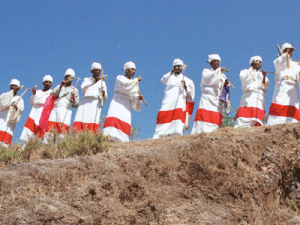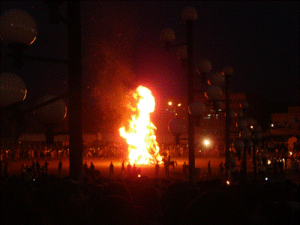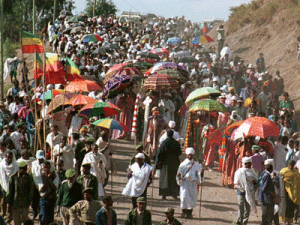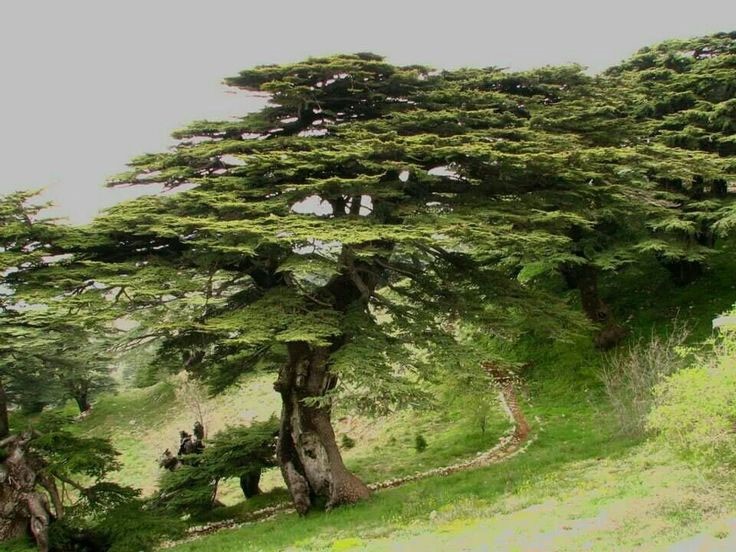Ethiopian Christmas – Genna (7 January)

In Ethiopia, the observance of Christmas takes place on the 7th of January, since the country continues to adhere to the traditional Julian calendar. To commemorate an occasion, individuals living in urban and rural areas often adorn themselves in their most elegant garments.
The Ethiopian name for Christmas is either Ledet or Genna, both of which are derived from the word “gennana” and have the connotation of imminence, symbolizing the anticipated advent of the Lord and the emancipation of mankind from sin.
When individuals congregate inside ecclesiastical establishments for the purpose of participating in the liturgical service known as mass, commencing promptly at 6:00am, the commencement of genna festivities ensues. The time of fasting before the Genna festival started 43 days prior for the clergy. It is imperative for the clergy to adhere to this period of thoughtful fasting, also known as the prophets’ fast. The primary objective of the Advent fast is to engage in a process of purifying both the physical and spiritual aspects of one’s being, in preparation for the forthcoming commemoration of the nativity of Jesus Christ. During a period of up to three hours, all individuals participate in a worship session in an upright position. For almost 1,500 years since Ethiopia’s embrace of Christianity, the clergy and Debtera, who are academics well-versed in church music and liturgy, have engaged in the melodic expression of their faith via the practice of chanting and singing. The culminating phase of this historical ceremony is represented by the grand Tabot procession, whereby a priest carries the symbolic Ark of the Covenant on their head. The procession is joined by the clergy and a sizable assembly of Christians, who carry illuminated candles. They are accompanied by ululation, the resonant sound of church bells, vibrant umbrellas, and vivid attire, as they circumnavigate the church three times.
Subsequently, individuals return to their own residences to partake in nourishment, while the ecclesiastical members begin their meal after a period of abstinence. Doro Wat, a spicy chicken stew, and Injera, a sourdough pancake-like bread, are traditionally consumed together over the Christmas season. Tej, a fermented beverage derived from honey and endemic to some regions, has resemblance to wine and is often consumed in conjunction with meals.
During intimate gatherings of close acquaintances and relatives, the celebration of Christmas is secretly exchanged and savored. Giving gifts is a rather small component in Ethiopian Christmas festivities. In domestic settings, individuals within familial and social circles engage in the exchange of modest gifts. The experience of deriving gratification from acts of giving and sharing extends beyond the confines of religious affiliation, serving as a catalyst for fostering benevolence towards others across all geographical locations.
Meskel – Finding of the True Cross (September 26th and 27th)

The observance of Meskel, a prominent festival within the Ethiopian Orthodox tradition, begins on September 26th and spans a duration of two consecutive days. Legend has it that Queen Helena, also known as Empress Helen and the mother of Constantine the Great, discovered the cross upon which Christ was crucified in the year 326. The individual sought help upon encountering difficulty in finding the Holy Sepulchre. They afterwards obtained instruction about the burial location of the cross via the smoke emitted by a vigorously burning fire. Queen Helena ceremoniously lit candles to commemorate her triumph after the revelation of the Holy Cross. During the Middle Ages, the Patriarch of Alexandria bestowed a portion of the True Cross onto Ethiopian Emperor Dawit as a gesture of safeguarding the Coptic Christians. The purported location of a relic believed to be a fragment of the True Cross is situated in the Gishen Mariam region, positioned around 70 kilometers northwest of Dessie. For countless centuries, this particular day has held the status of a national holiday in Ethiopia.
There are two occurrences of the Meskel celebration. One of the significant events is Demera, which takes place on September 26th. During this occasion, people make bonfires and set a crucifix adorned with flowers on each bonfire. The flowers known as Meskel Daisies are in bloom. The ceremonial act of lighting the lights is overseen by the Patriarch of the Ethiopian Orthodox Church. After a ceremonial invocation, the bonfires are ignited, prompting the commencement of communal singing and dancing in their vicinity. The priests engage in vocal performances while encircling the flames, donning full ceremonial regalia. Moreover, small-scale Demera celebrations are often organized inside private residences or community settings. The splinters formed from the combustion of wood bundles ultimately disintegrate. The direction in which objects fall, whether it be north, south, east, or west, has significant importance. The expeditious formation of interpretations about the potential existence of many agricultural fields, as well as uninterrupted tranquility throughout the year, is a common occurrence. According to the weather prediction, there is an anticipated occurrence of rainfall towards the completion of the Demera festival, which is expected to contribute to the extinguishing of the fire. There exists a prevailing belief that the attainment of a good year is contingent upon the occurrence of rainfall and the effective suppression of fires.
The celebration of Meskel traditionally takes place on the day after the Demera ceremony. Significant quantities of food and wine are eaten by those of faith during their journey to the Demera location, whereupon they use ashes derived from the fire to symbolically imprint the shape of a cross onto their foreheads. The festivities coincide with the annual blooming of the Meskel daisies, which are characterized by their vibrant golden yellow color. The internationally recognized Meskel Square, situated in the capital city of Addis Abeba, is considered an optimal site for observing the Meskel Festival. The celebration of Meskel is widely observed across the Historic Route, including cities like as Bahir Dar, Gonder, Axum, and Lalibela, along with other notable urban centers.
Timkat – Ethiopian Epiphany (January 19th or 20th)

On an annual basis, namely on January 19 (or January 20 during leap years), Ethiopian Orthodox Christians partake in the observance of Timkat, a significant festival commemorating the Baptism of Christ. This celebration has great cultural and religious significance throughout the nation, characterized by its lively and energetic nature. The event in question commemorates the baptism of Jesus Christ by John the Baptist. Ketera is the designated appellation for the eve of Timket. Subsequently, the Tabots associated with each church are ceremoniously transported in a procession to a nearby river or body of water, where the following day’s festivities are scheduled to occur. Every Tabot is housed in an own tent, which is erected as church choir members sing songs. The drums are rhythmically struck, bells are resonantly rung, and trumpets are resoundingly blasted while the priests engage in a specific ceremonial dance, grasping their sistera and prayer sticks.
The Tabot symbolizes the sacred tablets containing the Law and the Ark of the Covenant, which were bestowed onto Moses during his encounter on Mount Sinai. The Tabot is the revered item that is the primary focus of adoration, as opposed to the physical construction of the church itself. When the Tabot is unveiled, it is adorned with brocade or velvet fabric, reminiscent of the cloak of Christ. It is then placed on a priest’s head, who is accompanied by vivid ceremonial parasols for shade. The priests engage in nocturnal devotional practices, dedicating the night hours to prayer, while the celebration of mass takes place at around 2:00 am on the following day. As morning approaches, people congregate by the river and participate in communal prayer rituals. After the recitation of the prayer, a clergy member of higher rank proceeds to bestow a sacred blessing into the water, using a processional cross made of gold. Additionally, they proceed to extinguish a lighted consecrated light inside the water. Subsequently, as a gesture of reverence for the baptism of Christ, the individual proceeds to disperse the water upon the assembled congregation. A significant number of fervent individuals engage in the act of immersing themselves in the water while retaining their garments as a means to reassert their commitments.
The Timkat ceremony might be seen as a commemorative event rather than an annual reenactment of baptism. After the baptism ceremony, the Tabots of all churches, with the exception of St. Michael’s, begin their journey back to their respective edifices. The elders participate in a somber procession, accompanied by the singing and leaping of priests and young men, as well as the rhythmic sound of staffs and prayer sticks, in remembrance of the ceremonies described in 2 Samuel Chapter 6 of the Old Testament.
The prominent saint in Ethiopia, widely recognized and revered, celebrates his feast day on January 20, coinciding with his birthdate. The Tabot of St. Michael’s is ceremoniously brought back to its church on a certain morning, accompanied by priests and local inhabitants adorned in vibrant attire, engaging in song and dance. The three-day event is concluded. The Ethiopian Orthodox Church conducted a distinctive liturgy that originated within a rather isolated context, apart from global influences.
Lalibela, Gonder, and Addis Abe are considered to be optimal destinations for seeing the event. Several tents have been constructed in Addis Abeba, namely in the grassy region near Jan Meda, which is located northeast of the city center. A gathering of individuals who have prepared packed meals to partake in while illuminated by oil lamps participate in a religious service at the early hour of 2:00 a.m. At sunrise, the priest uses a ceremonial cross to extinguish a lit candle affixed to a pole that is immersed in a nearby river. A number of individuals from the congregation immerse themselves in the river. The festivities continue as the Tabots are afterwards escorted in a parade back to the Churches on horseback.




